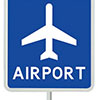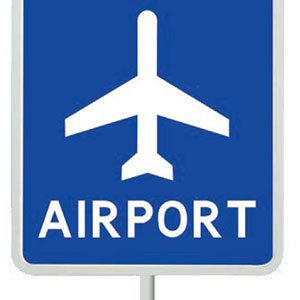
Keeping in Touch
Indianapolis airport secures parking structures with call boxes while a charter bus company keeps an eye on everyday threats with video surveillance
- By Ralph C. Jensen
- Nov 01, 2013
 About five years ago, the Indianapolis Airport Authority pulled up
stakes and moved to the other side of the city’s airfield with new
facilities and new security systems. Among them, a group of call
boxes were installed to offer customers peace of mind and security.
Located 16 minutes from downtown Indianapolis, the airport
averaged about 140 flights per day in 2012, serving approximately 7.3 million passengers.
It accomplished this by serving 32 nonstop destinations on eight major
airlines.
About five years ago, the Indianapolis Airport Authority pulled up
stakes and moved to the other side of the city’s airfield with new
facilities and new security systems. Among them, a group of call
boxes were installed to offer customers peace of mind and security.
Located 16 minutes from downtown Indianapolis, the airport
averaged about 140 flights per day in 2012, serving approximately 7.3 million passengers.
It accomplished this by serving 32 nonstop destinations on eight major
airlines.
As one of the first new airports to open in the United States since Sept. 11,
2001, Indianapolis International Airport (IND) is a 1.2 million-square-foot complex
just off Interstate 70, which is strategically located from several major U.S.
interstates, including I-65, I-865, I-69, I-70 and I-74, all of which connect to the
city’s I-465 beltway.
The newness of the airport also means it is a destination and launching pad for
both commerce and community. As the eighth largest cargo center in the United
States and the home of the second largest FedEx Express operation in the world,
more than 2 billion pounds of cargo were managed at IND in 2012. This is a key
economic catalyst for development in central Indiana and the Midwest.
As impressive as these economic numbers seem, however, it is the customer that
gets top billing from airport authorities. At the old airport, travelers who needed
assistance only had a telephone in the box to call for help. It worked...most of
the time. Today, travelers who need immediate help simply pick up a receiver on a
Talk-A-Phone call box to be connected to guest services or, if it is a medical emergency
(or worse), they are connected to the airport’s 911 services.
“The transportation industry is one of our core markets,” said Sam Shanes,
chairman of Talk-A-Phone. “We’ve been involved in several airport installations,
including airports in Atlanta, Dallas, Chicago and many others. Ensuring the security
of passengers in the travel sector is something we take very seriously.”
One layer of security that IND airport officials installed is call boxes in numerous
common areas within the parking structure: the parking garage, in surface
parking areas and strategically placed at gate access points.
“Having these call boxes is another service we are pleased to provide to our
passengers with as an added sense of security,” said Airport Operations Center
and Emergency Operations Center Manager, Andy Burnett. “The system at the
old terminal was a telephone in a weatherproof box. Our design team planned for
reliability and reputation in planning for this solution.”
Though the call boxes serve more than one function—in short, for non-emergencies—
operators patch the call through to guest services and are able to assist
passengers with common questions about locations and general services.
Airport officials also worked diligently with Talk-A-Phone to produce aesthetically
pleasing call boxes, and passengers are able to spot the towers and know that
there is shelter there, as well.
“This is one more layer of security for our passengers,” Burnett said.
While airports across the nation may seem the most visible in terms of highvolume
transportation, charter bus service also carries thousands of passengers on
a weekly basis, making it a booming business nationwide.
Miller Transportation Inc. has been providing reliable charter bus service to the
Indiana and Kentucky region for more than 25 years. Based in Indianapolis and Louisville, Miller Transportation offers
the largest selection of modern motor
coaches in the Midwest, specializing in
charter, minibus, trolley and shuttle van
transportation. It is renowned in the industry
for its superior professionalism
with a fleet of CVSA-certified buses, uniformed
drivers and a large service facility
staffed with highly-trained mechanics.
Tens of thousands of people use
chartered bus services every day to go
to school and work, to visit entertainment
venues or to vacation in places
near and far. Factors, such as an aging
U.S. population and higher fuel
costs, have led to increased travel by
bus. To leverage the higher demand
for chartered bus service, Miller built
a $5 million state-of-the-art facility
in Louisville in 2013, consisting of a
26,000-square-foot bus maintenance
center and a 24,000-square-foot administrative
office, connected by a walkway.
Miller turned to integrator Indatus
of Louisville, a full-service, data communications
contractor, to provide
phone systems, network infrastructure,
cabling, building access and video surveillance
for the new building.
“Because it was new construction,
we were able to install cutting-edge infrastructure
and network cabling for
both the company’s LAN and for the
video surveillance system,” said Scott
Langley, Indatus project manager. “We
also put in an access control and phone
system. This is truly the latest in data
communications technology.”
When it came time to install the
video surveillance system, Langley was
asked to engineer it so that not only
would it provide visual recordings of
everyday threats, such as vandalism or
theft, but also give management vantage
points to remotely monitor the goings-
on inside the maintenance center
with its bus lifts, wash bays, fueling station
and busy mechanics. Additionally,
Miller wanted cameras to capture buses coming in and out from its active parking
lot in the rare event of an accident.
Indatus recommended that Miller install
a Toshiba NVSe network video recorder
in both the garage and the office
building. Each NVSe is equipped with its
own separate NIC cards, keeping camera
traffic off the company’s LAN. As
a safety precaution, Indatus purchased
additional licenses for the two NVRs;
in case one went down or was sent out
for repairs, the other could pick up a few
cameras from the other building.
Miller installed central station software
on both NVSe units for complete
remote access, set-up control, user administration,
video backup, live viewing
and powerful search capabilities.
The recorders have dual monitor support
via HDMI and DVI, a feature that
Indatus uses in the garage for viewing
on a desktop monitor with sequencing
for four cameras and provided management
with Surveillix mobile software
for viewing live cameras on smartphones
and tablets.
Indatus installed 34 Toshiba IP
cameras in the garage and another
22 inside the administrative office. IP
dome cameras, with 1080p HD resolution,
were deployed inside the buildings,
while IP bullet cameras went
outside. Both cameras have the high
resolution necessary to capture small
details over large monitoring areas.
For example, after the building was
complete, someone drove over an island
and left deep rut marks in the
new sod. Miller was able to review the
video and quickly identify the driver
by using the preview search.
The IK-WD14A camera offers builtin
SRLED to help capture video in near
complete darkness along with a wide
dynamic range for challenging back
lighting environments. The camera also
offers simultaneous H.264/MPEG4/
MJPEG streaming for automatic bandwidth
prioritization, enabling seamless,
full frame (1920 x 1080) video at up to
30 frames-per-second for both live viewing
and recording. Imaging performance
is further enhanced by the camera’s onetouch,
3x, remote zoom, remote focus
and broad-angle pan and tilt.
“High definition is the most prominent
trend in the IP camera space,” said
Sergio Collazo, director of sales and
marketing for Toshiba Surveillance &
IP Video. “The IK-WD14A is a natural
extension of Toshiba’s IT culture
and history of innovation in consumer,
high-definition video.”
Outdoors, Indatus selected a rugged
Toshiba, IP-66-rated, bullet camera to
withstand the punishment of wide temperature
swings, rain, ice and snow. Plus,
it is tamper- and vandal-resistant, in
the event that intruders attempt to disable
it. And, like the IK-WD14A, it has
advanced IR LEDs to provide 0.0 lux
minimum illumination so nothing outside
escapes detection.
This article originally appeared in the November 2013 issue of Security Today.